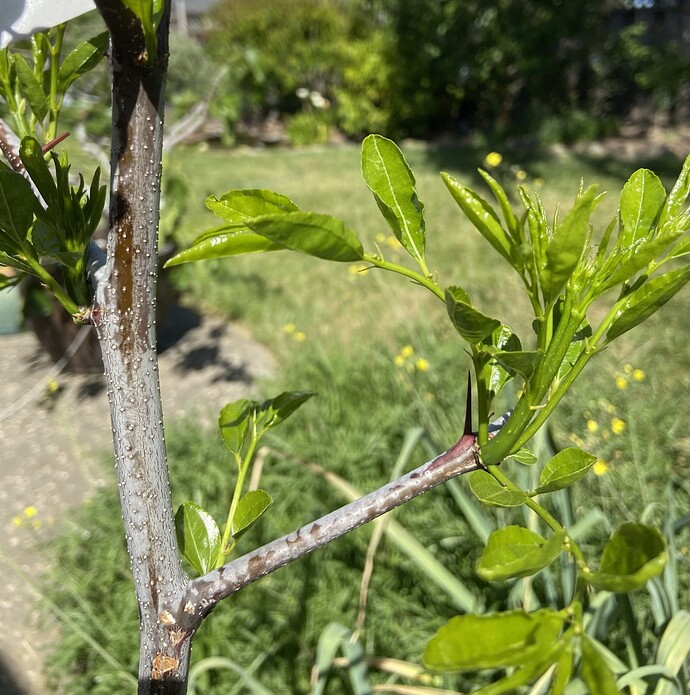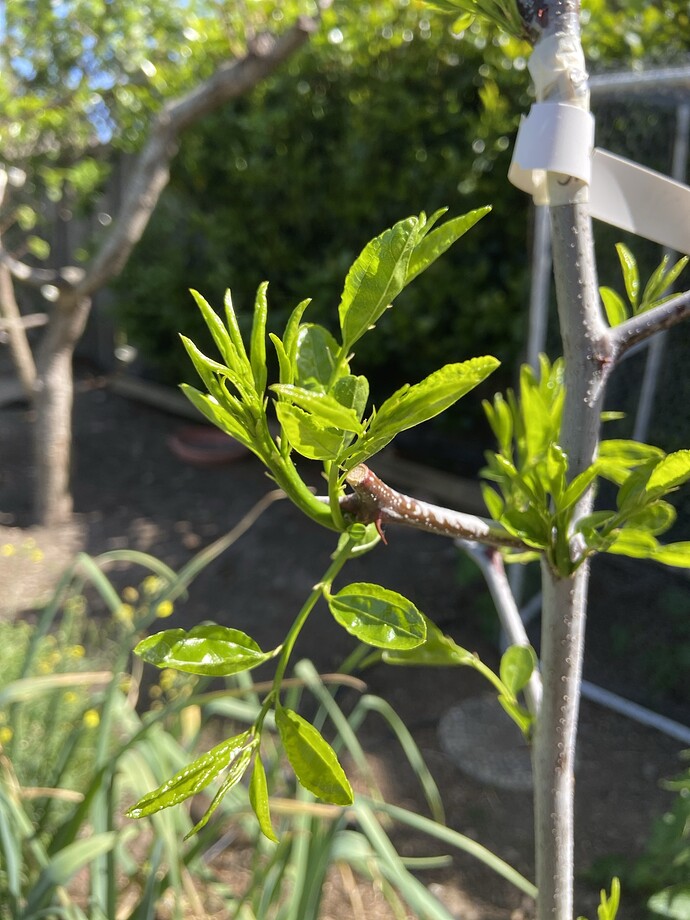That is my logic too. First parafilm to secure the graft or bud in place and stop immediate drying of exposed cambium…then whatever else to tighten up the connection together.
Wait a few weeks later than normal, and graft dormant scions onto green upright shoots. The green shoots are soft, so really easy to cut cleanly without hurting yourself. The scions are still hard wood, but you can prepare them in the comfort and safety of an indoor bench. Green shoots also heal really fast.
I made another dozen jujube grafts today and tried your method on a few. Though on the first one it was because I forgot the tape in the garage, but had the parafilm in my pocket… 
I din’t really see any benefit for the large cleft graft. In fact, I’d worry that the parafilm wouldn’t pull it closed enough and then when the temflex does pull it closed that it could force some parafilm into the graft union.
But, some of the grafts I was making were very (very!) thin cleft grafts on potted rootstocks (some planted from seed last year). In that case, I found that the parafilm was enough to hold it completely closed, and was much easier to apply. Then tape on top went on pretty easily. But when trying to apply the temflex as a first layer, it was applying too much force sideways and pulling the tiny flap of wood at the union to the side. Something similar can be achieved by pre-stretching the tape, after cutting it in half lengthwise (so it isn’t much wider than an elastic band). But, I think the parafilm-first was still a bit easier to apply for the ultra-thin scions.
The rootstocks that had so many thorns were suckers I dug up last fall. 7 of the grafts I made today were on seeds I planted in early 2020 and they had much more predicable seeds. They were all from fruit which was decent eating (not wild jujubes), so I guess it makes sense that the thorns would be a bit more manageable.
Bob,
I can see your concern about wrapping with parafilm first with a large cleft graft. How large is your cleft graft of jujubes? Mine were no larger than a 1/2” in diameter so there has not no such an issue.
Unlike the tags, the green garden tape was supposed to be temporary labels. I have gotten busy and by the time I got around to replace it with more permanent tags, some writing were not readable.
Writing a location of a graft in a coordinating system is a nice idea but probably harder for me to apply. I generally place many graft on a tree which could lead to confusion. I know some people draw nice pics of their trees with descriptions of their grafts. I do not possess such skills!!. I hope to get around to put tags on sooner than later. Thanks for your suggestions.
Do you get a good success rate on those tiny grafts? I’ve been waiting until my seedlings get a lot bigger before grafting.
That’s not an easy question to answer, but I’m glad that you asked. I’ve recently been going along with the assumption that everything I do will work and churning out a lot of grafts. The last time I was feeling confidant and did that (3-4 years ago), I had ~100/101 peach & nectarine grafts fail 
I meticulously keep track of everything I graft (all 2174 grafts…), but I don’t have good follow-up data on later success. There have been times in the past when I recorded which grafts took and which failed. During one year, I even recorded how much they grew by mid-July.
Much of the data isn’t so useful here due to a lack of differentiation and limited sample. These examples don’t necessarily show that tiny is good, but that I most often screw up with larger scions.
2016 pears: 28/29 grew (failure was a VL- Very Large scion)
2016 Euro plums: 20/22 grew (failures of Med-Lg and Lg scions)
2017- Jujube 19/20 grew (VLwas failure)
I suspect that the reason for this is that with thinner scions, I am able to compensate for my poor wood-working skills by pulling the slightly mismatched wood together. But with larger wood, it is more likely that even pulling hard could leave a gap in poorly fit grafts (which I generate plenty of). Most of the above grafts were cleft grafts, with a few double-clefts thrown in.
I did find one period where there was a bit more failures. Interestingly, it was with apples, something which I normally have high success levels (95%+).
April 2016 apple grafts
| Size | Grafts | Takes | Pct | Avg Growth |
|---|---|---|---|---|
| Thin | 4 | 3 | 75% | 1” |
| Medium Thin | 8 | 7 | 88% | 4” |
| Medium | 7 | 6 | 86% | 9.2” |
| Medium Large | 8 | 5 | 63% | 6.7” |
| Large | 9 | 3 | 33% | 2” |
Small sample size (most things a single person does will be…), but it seems like the medium wood produced the best growth. This actually surprised me a bit, as I would have thought Medium-Large or even large was best. I think I’ve suspected that VL may be non-optimal (though there weren’t any in these 36 grafts), due to the number of times I’ve felt unhappy about the contact in a VL graft.
I should also further qualify the above by:
1.) I don’t know offhand the exact diameters for each of the sizes, as it is something I do by eye. When I’m next grafting, maybe I’ll use a ruler and get some approximate figures.
2.) Even if you trust the above results, it doesn’t necessarily apply to jujube. I’ll try to capture the data on my jujube grafting this year (185 total, with 27 being potted or un-established, like suckers, etc).
I’ll do some measurements, but I’m pretty sure that I consider Large to be far less than 1/2". Maybe this just highlights my reliance of smushing wood together rather than making a high-quality precision match…
I’ve had that happen, but even in that situation, I can usually narrow it down to 2 or at most 3 possibilities.
I’ve also been re-evaluating how many varieties I should put on a tree, because it makes things so complicated. I’m actually leaning toward trying to keep things to 5 or 6 varieties (original host, and one for each compass point, with maybe one more for the upper central leader).
I’ve noticed that things seem to get pretty messy when I have too many and I risk either losing varieties through pruning or losing a ton (too many eggs in one basket) if the tree dies (I lost 20+ apple varieties one time when tree died…).
I don’t have such skills either, but I can enter data in a spreadsheet 
I use my phone to record the info, then transcribe it into Excel each night.
Seems like primary shoots grew out from nodes do secondary shoots. This is first year bareroot tree planted in pot in February this year. Is this possible?
Yes. Primary shoots can grow from nodes on secondary shoots. Also primary shoots can grow laterally and still be primary branches. They will be differentiated by having lateral or secondary shoots come off them.
Your tree is showing vigorous growth!!! 

Does that mean if we graft a primary shoot to a secondary shoot, it’s also possible to see primary shoot grow out from the scion the year it’s grafted? Have you grafted to a secondary shoot before?
yes, that is possible, and vice versa.
many of us have, am sure 
such grafts do much better if getting plenty sun
Thanks for sharing your experience.
What temperatures are required for Jujube to end dormancy and grow. We have had 3 weeks of temperatures of 40s at night and 60s during the day. Two days in the 70s. My Jujubes are showing some green but very limited growth. May 10th and this is my most vigorous Jujube. 
They like it hot. I think they just need a bit more time. I have some rootstocks here that are just now starting.
I’ve never understood this primary secondary branch business in jujubes. I just prune them like I prune peaches. I tried reading Dr. Yao’s writing on it but thought it was just too confusing and way too much reading. If anybody knows of a dumbed down YouTube video on the matter, lemme know!
Don’t worry about it. I’m near DC and mine are not much more that yours.
Dan,
Our temp here has been similar to your. My jujubes have less growth than yours. I am not worried. They will grow when it is warm up.
Susu,
You are not alone. I think a couple of people posted a great tutorial about jujubes, its structure, how they grow, how to manage them, etc, etc.
I read it and it confused the heck out of me so I just gave up. Two years ago, a friend brother visited us. He is an experienced grower who has grown jujubes for 25 years in CA. He pointed out a few things and gave me suggestions how to prune my jujubes.
I think I forgot what he suggested before he touched down in CA. Where I grew up, we had many Indian jujubes of various varieties. No one ever pruned them. I figure I don’t need to prune mine, either. I just topped them off when I could not reach the top of the trees standing on the top step of my ladder.
This makes me feel better. I’ll keep doing what I’m doing. At least I’ll get some fruit. And the tree will stay short enough. 
Susu,
I topped my jujube trees at about 10 ft.
However, I have changed my mind and strategy. I will let them grow taller. I have found that when ripe, the fruit will fall off with gentle shaking (my “gentle” may not what you consider gentle). Fruit did not bruise when fell. I do not have to risk my life climbing a ladder to pick them any more.
More limbs, more fruit. That’s how I look at it.
Can anyone tell me if you have the same or similar experience?
For the past 3 years that I have grafted jujubes (on existing trees), some grafts would grew well one year and died the next year. This has happened to me 3 years in a row. I can’t tell why they did not wake up on their second year.
For example,
Dong Zao, grafted and leafed out in 2019. Died in 2020
2 grafts of Sihong in 2020 , both took. One comes back this year, the other did not.
@jujubemulberry , @k8tpayaso , @tonyOmahaz5 , @BobVance , et al,
Have you had grafts that took and grew one year and died the next year without an obviuos reasipon?


